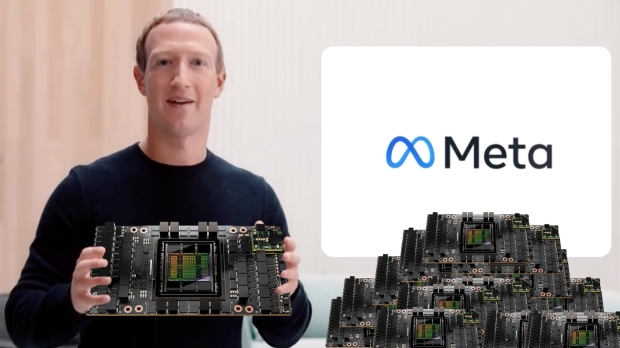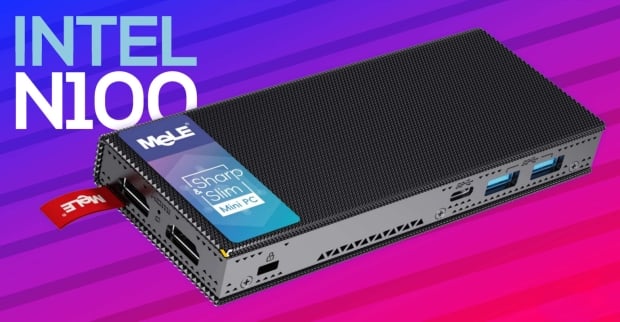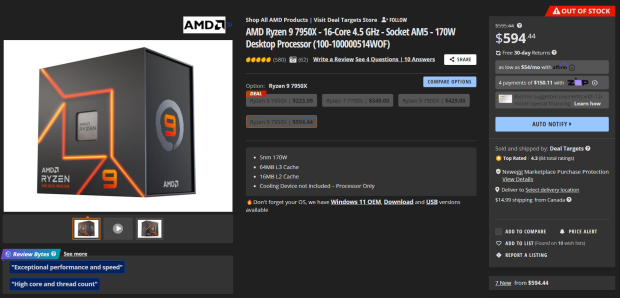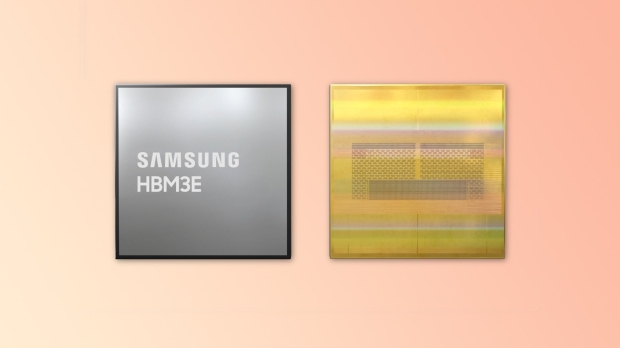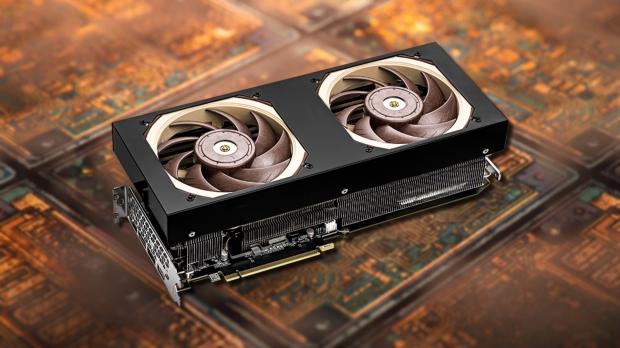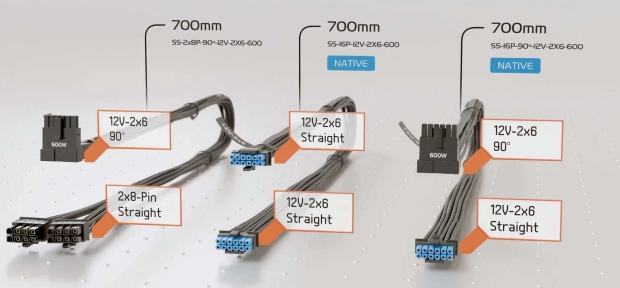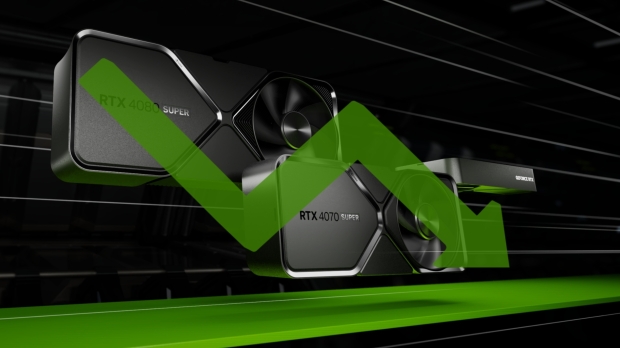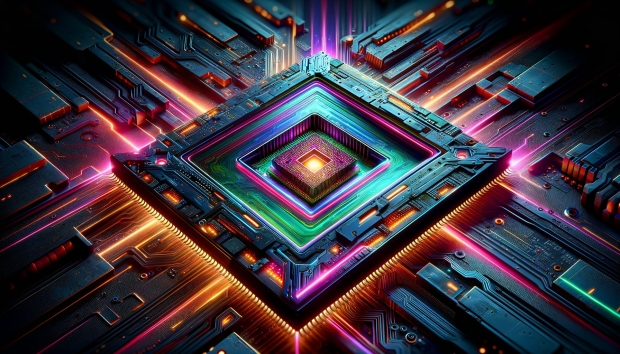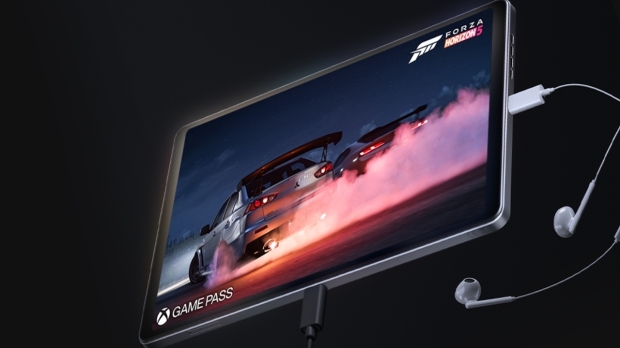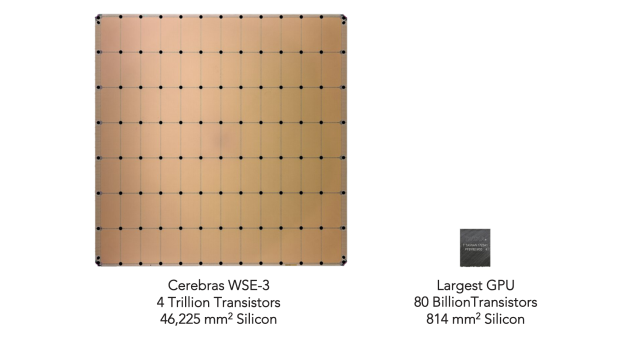Meta has two new AI data centers equipped with over 24,000 NVIDIA H100 GPUs
We know that AI is big business, and that is why companies like Microsoft, Meta, Google, and Amazon are investing mind-boggling amounts of money in creating new infrastructure and AI-focused data centers. As per Meta's latest post regarding its "GenAI Infrastructure," the company has announced two "24,576 GPU data center scale clusters" to support current and next-gen AI models, research, and development.
That's over 24,000 NVIDIA Tensor Core H100 GPUs, with Meta adding that its AI infrastructure and data centers will house 350,000 NVIDIA H100 GPUs by the end of 2024. There's only one response to seeing that many GPUs: a comically long and cartoonish whistle or a Neo-style "Woah." Meta is going all in on AI, a market in which it wants to be the leader.
"To lead in developing AI means leading investments in hardware infrastructure," the pot writes. "Meta's long-term vision is to build artificial general intelligence (AGI) that is open and built responsibly so that it can be widely available for everyone to benefit from."
This new pocket-sized PC features an Intel N100 'Alder Lake-N' CPU, fanless design
MeLE has just revealed its new stick PC, featuring an Intel N100 "Alder Lake-N" processor, which will fit in your pocket. Check it out:
The new MeLE pocket-sized PC measures just 146 x 61 x 20mm and weighs only 184g, which makes it about the size of a regular smartphone. Inside, we've got the Intel N100 "Alder Lake-N" processor with 4 cores -- all Efficient cores --operating at between 800MHz and 3.4GHz.
We've got 8GB or 16GB of LPDDR4X-4266 memory and either 128GB or 256GB of eMMC storage, which isn't expandable. MeLE includes two USB 3.2 ports for external storage if needed. On the GPU side of things, the MeLE pocket-sized PC features Intel UHD graphics with 24 Execution Units, which support dual 4K 60Hz displays. There's no DisplayPort here, but there is USB Type-C, which unfortunately doesn't have DP Alt mode.
AMD Ryzen 9 7950X used by cryptominers, making $3 per day in profit from their CPUs
Uh-oh... it's starting again... AMD's current-gen Ryzen 9 7950X processor has become a super-popular CPU for crypto mining, earning higher profits than some of the fastest GPUs on the market.
Our friends at Wccftech are reporting that because of the rise of Bitcoin pricing, CPUs are being used for crypto mining, whereas Qubic (QBIC), crypto miners are using CPUs that have AVX2 and AVX512 instructions on the Zen 4 architecture, which are great for crypto mining. Intel dropped AVX512 support for its processors, starting with Alder Lake, seeing crypto miners flocking to Ryzen 7000 series processors.
AMD processors were used for Raptoreum mining algorithms, using the huge L3 cache on Ryzen and Threadripper CPUs. 3D V-Cache models featured gigantic pools of cache stacked on the chips, perfect for crypto mining. Qubic (QBIC) coins generate a profit of around $3 per 24 hours, including the electricity cost of running a Ryzen 9 7950X processor, even at 170W of power consumption.
Samsung to use MR-MUF technology, like SK hynix, for its future-gen HBM products
Samsung is reportedly using MUF technology for its next-gen HBM chip production, with the South Korean giant reportedly issuing purchasing orders for MUF tools.
The company says that the "rumors" it will use MUF technology are "not true," according to Reuters, which is reporting the news. HBM makers like SK hynix, Micron, and Samsung are all fighting for the future of HBM technology and future-gen AI GPUs, and it seems Samsung has its tail between its legs now.
One reason Samsung is falling behind is that it has stuck with its chip-making technology, non-conductive film (NCF), which has caused production issues. Meanwhile, HBM competitor and South Korean rival SK Hynix has switched to mass reflow molded underfill (MR-MUF) to work through NCF's weakness, "according to analysts and industry watchers," reports Reuters.
Sycom's Silent Master GeForce RTX 4070 Ti SUPER uses Noctua Fans and it's 3.8 slots thick
Sycom has announced two new GPUs for its 'Silent Master' range: the GeForce RTX 4070 SUPER and the GeForce RTX 4070 Ti SUPER. Like previous releases in the series, the Japanese company has partnered with Noctua to deliver its whisper-quiet GPU cooling, powered by Noctua's flagship NF-A12x25 PWM fans.
Throw in a custom fan cover and steel frame from Japanese company Nagao Manufacturing Co., Ltd, generous heat sinks with copper pipes, and a metal backplate, and you've got near-silent performance even when under load. Sycom claims 31.4 dB noise levels for the RTX 4070 Ti SUPER when idle and 42.1 dB under load - a full 12 dB quieter than the competition.
Plus, the use of Noctua fans also keeps temperatures down - with Sycom saying you can expect the GPU to run with temperatures around 5 degrees cooler than the competition. And you're looking at two fans instead of the traditional three for a high-end GPU. However, there is a catch - a big one. Literally.
Seasonic introduces upgraded 12V-2x6 (H++) 600W power cables for its PSUs
Seasonic has just upgraded its GPU cables for some of its power supply units with upgraded H++ connectors that are compliant with the new PCIe Gen5 and ATX3 standards.
The new 12V-2x6 power connectors now replace the current H+ (12VHPWR) power cables, with three versions of the cable specifically made by Seasonic for its power supplies. The new native 12V-2x6 power cable is compatible across multiple Seasonic ATX 3.0 power supplies, including the Prime TX, Prime PX, Vertex GX/PX, and Focus GX power supplies.
These cables won't work with ATX2-based power supplies, but the new native cables feature blue connectors on one side, which is nice to see. If you see blue, you know your cable isn't connected properly... nice and easy installation from Seasonic here.
GeForce RTX 40 SUPER Series GPU pricing falls below MSRP in Germany
NVIDIA kicked off 2024 with the release of its GeForce RTX 40 SUPER Series refresh, which included three GPUs: the GeForce RTX 4070 SUPER, the GeForce RTX 4070 Ti SUPER, and the GeForce RTX 4080 SUPER. With improved performance and, in some cases, new pricing (the RTX 4080 SUPER got a sizable price cut), it reshuffled the GeForce RTX 40 Series line-up with more choices.
This has led to increased competition, with AMD lowering the price of some of its RDNA Radeon RX 7000 Series GPUs in recent months (like the Radeon RX 7900 XT and Radeon RX 7700 XT) and even introducing a new model - the Radeon RX 7900 GRE - in the competitive $500 to $600 USD price range. Fluctuating GPU pricing is not unusual in the current climate, nor is it seeing things stabilizing and sticking closer to MSRP.
However, in one market - Germany - the entire GeForce RTX 40 SUPER Series is currently being sold for less than the MSRP. This information comes from ComputerBase (via Videocardz), which reports that cards like the GeForce RTX 4070 SUPER are available in the country for prices well below MSRP.
Continue reading: GeForce RTX 40 SUPER Series GPU pricing falls below MSRP in Germany (full post)
JEDEC chills on next-gen HBM4 thickness: 16-Hi stacks with current bonding tech allowed
HBM3E memory is about to be unleashed with NVIDIA's upcoming beefed-up H200 AI GPU, but now JEDEC has reportedly relaxed the rules for HBM4 memory configurations.
JEDEC has reportedly reduced the package thickness of HBM4 down to 775 micrometers for both 12-layer and 16-layer HBM4 stacks, as it gets more complex at higher thickness levels, making it easier... especially as HBM makers fly in the face of insatiable demand for AI GPUs (now, and into the future with HBM4-powered chips).
HBM manufacturers, including SK hynix, Micron, and Samsung, were poised to use hybrid bonding with the process, a newer packaging technology, and more to reduce the package thickness of HBM4, which uses direct bonding with the onboard chip and wafer. However, HBM4, being a new technology, sees that hybrid bonding would increase pricing, making HBM4-powered AI GPUs of the future even more expensive.
Lenovo is bringing its Legion Tab Android gaming tablet to more markets
Designed for the "modern mobile gamer," the Lenovo Legion Tab is an 8.8-inch Android tablet for mobile gaming that the company is bringing to more regions. Originally available in China, the Lenovo Legion Tab will soon be available in EMEA (Europe, Middle East, Africa, and Asia) for €599 (including VAT).
As far as tablets go, this one is powerful, thanks to its Qualcomm Snapdragon 8+ Gen 1 4nm processor, 12Gb of LPDDR5X memory, 256GB of onboard storage, and 144 Hz QHD+ Lenovo PureSight display. Unlike the Lenovo Legion Go, a Windows 11 gaming handheld, the Legion Tab is designed to play Android-compatible games. Plus, cloud-based gaming with Xbox Game Pass and GeForce NOW.
Other notable features of the Lenovo Legion Tab are its support for USB Type-C display output (DisplayPort 1.4) so you can connect the device to an external display, the large 6550mAh battery for long gaming sessions, and the integrated haptics.
Cerebras Systems unveils CS-3 AI supercomputer: can train models that are 10x bigger than GPT-4
Cerebras Systems just unveiled its new WSE-3 AI chip with 4 trillion transistors and 900,000 AI-optimized cores... as well as its new CS-3 AI supercomputer.
The new CS-3 AI supercomputer has enough power to train models that are 10x larger than GPT-4 and Gemini, which is thanks to its gigantic memory pool. Cerebras Systems' new CS-3 AI supercomputer has been designed for enterprise and hyperscale users, delivering huge performance efficiency gains over current AI GPUs.
The new Condor Galaxy 3 supercomputer features 64 x CS-3 AI systems, packing 8 Exaflops of AI compute performance, which is double the performance of the previous system, but at the same power... and the same cost.

